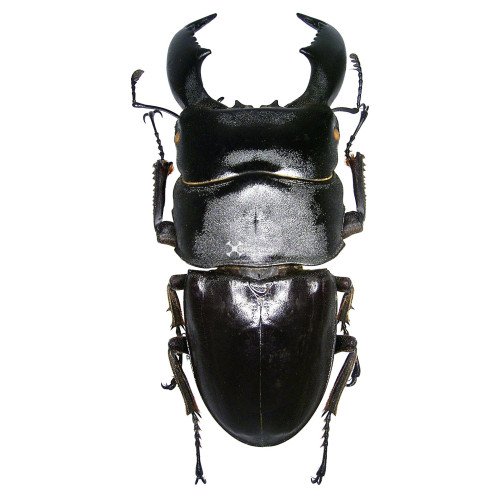
The Dorcus titanus is a striking species of stag beetle belonging to the family Lucanidae, native to Southeast Asia, including various Indonesian islands such as Sumatra, Java, and Borneo. It is one of the largest and most recognized stag beetles in the region, with males often reaching lengths of up to 110 mm, including their formidable mandibles. These mandibles are not just for show—they're used in combat with rival males, especially during mating season, to compete for access to females. The beetle’s body is typically a glossy black or deep brown, with a robust, armored appearance and a notable sexual dimorphism, where females are smaller and have less prominent mandibles.
In Indonesia’s tropical rainforests, Dorcus titanus thrives in moist, decaying wood environments where larvae feed on rotting logs and organic matter. The adult beetles emerge after a lengthy pupation period and are usually active at night, feeding on tree sap or overripe fruits. Due to their impressive appearance and relatively calm temperament, they are popular among insect collectors and beetle enthusiasts, both locally and internationally. However, this demand has also led to concerns over habitat loss and overcollection, prompting some conservation awareness regarding their ecological role and sustainable practices.
We firmly support the sustainable tropical butterfly collections as long as they take care of conserving the rainforest where they fly and developing responsible conscious trading.
This allows us to support local ranching farms with ethically sourced material and help at the same time collectors and enthusiasts to contribute to understanding and treasuring those species.
Please take into consideration that the specimen that you will receive may slightly differ in size, shape or colour from the picture shown as you are purchasing a natural product.
All our items are carefully delivered to prevent damages on transport, papered items are packaged in glassine envelopes specifying capture/breeding data and location available. CITES certificate will be provided in the specimens required.
HOW WE GRADE OUR LISTINGS (SPECIMENS)
As Insect specimens are natural products, some are bred and some others caught in wild, the quality can vary greatly.
The guide below explains the grading used for specimens in our listings.
A1 No visible imperfections, both antennas, no tearing, scratches or missing part of the wings (or as perfect as you could expect from wild caught specimens), with exception of some leg damage.
A1- Very minor damage, normally restricted to antenna damage or antennae attached separately in the envelope.
A- These specimens have minor damage, such as antenna damage, or minor flight wear such as small scratches, minor sale damage, some minor fraying/chipping around the edges of the wings.
A2 More significant damage, such as major flight wear, small rips, small pieces missing from the wings, damage to the thorax or abdomen.
B or Second Grade These specimens have similar damage to A2 specimens, but to a more significant degree. Usually used as parts replacement or art work material
| SPECIMEN | |
|---|---|
| Country | Indonesia |
| Average size | 70 to 80+ mm |
| Locality | West Java |
| Collection type | Wild collected |
| Bio-zone | Indomalayan |